
Fort Lawrence was a British fort built during Father Le Loutre's War and located on the Isthmus of Chignecto (in the modern-day community of Fort Lawrence).

Fort Lawrence was a British fort built during Father Le Loutre's War and located on the Isthmus of Chignecto (in the modern-day community of Fort Lawrence).
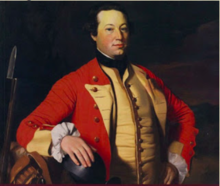
Despite the British Conquest of Acadia in 1710, Nova Scotia remained primarily occupied by Catholic Acadians and Mi'kmaq. Father Le Loutre's War began after Edward Cornwallis arrived to establish Halifax with 13 transports on June 21, 1749. [1] The British quickly began to build other settlements. To guard against Mi'kmaq, Acadian and French attacks on the new Protestant settlements, British fortifications were erected in Halifax (1749), Bedford (Fort Sackville) (1749), Dartmouth (1750), Lunenburg (1753), and Lawrencetown (1754).
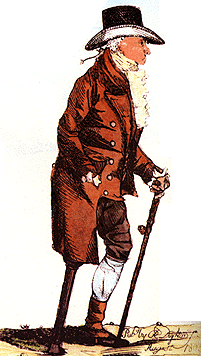
Within 18 months of establishing Halifax, the British also took firm control of peninsula Nova Scotia by building fortifications in all the major Acadian communities: present-day Windsor (Fort Edward); Grand-Pré (Fort Vieux Logis) and Chignecto (Fort Lawrence). A British fort (Fort Anne) already existed at the other major Acadian centre of Annapolis Royal, Nova Scotia. Cobequid remained without a fort.
In the spring of 1750, a British Army expeditionary force under Major Charles Lawrence arrived at Beaubassin. The village was ordered burnt by the French priest Jean-Louis Le Loutre to ensure that the British could not profit from its seizure. The British forces soon found they were outnumbered by Acadians and Mi'kmaq. Lawrence's troops retreated but returned in September 1750 in greater numbers and engaged in the Battle at Chignecto.
After Le Loutre's militia retreated, Lawrence began to build Fort Lawrence, a palisade fort on a ridge immediately east of the Missaguash River, the disputed border between Acadia and Nova Scotia since the Treaty of Utrecht was signed, and within sight of Fort Beausejour. The structure was completed under the command of Captain John Handfield. 16 September 1750, the natives killed two soldiers and 11 rangers went missing. Two days later, natives took the ship Fair Lady with 5 crew on board. [2] On October 4, Howe was killed. Oct. 11 Mangers schooner taken and burned. November 17, natives take five prisoners in front of the fort. [3] Nov. 23, natives fired on cattle. Nov. 30, natives attacked a wood party, wounding three. [4]
On August 15, 1752, Lt. Col. Robert Monckton took command of Fort Lawrence. [5] [6]
In 1753, Captain George Scott took command of the fort and in May, warriors scalped two British soldiers. [7] Scott made contact with the spy Thomas Pichon. Scott relinquished command of Fort Lawrence in the autumn of 1754 and Captain John Hussey took over command. [8] Preparations were then being made for an attack on Beauséjour, and he was appointed to command one of the two battalions of Massachusetts troops. He played a considerable part in the brief siege.
Fort Edward, Fort Lawrence, and Fort Anne were all supplied by and dependent on the arrival of Captains Cobb, Rogers or Taggart, in one of the government sloops. These vessels took the annual or semi-annual relief to their destination. They carried the officers and their families to and fro as required. [9]
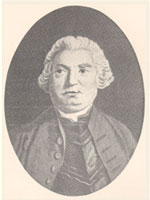
The Battle of Fort Beausejour ended Father Le Loutre's War and began the French and Indian War in the region. On June 4, 1755 the British conquest for all of France's North American territory began when a force of British regulars and New England militia attacked Fort Beauséjour from Fort Lawrence under command of Lt. Col. Robert Monckton. The British-led force took control of Fort Beauséjour by June 16, 1755, after which they changed the name to Fort Cumberland.
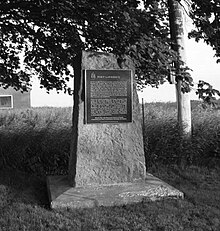
In the ensuing months, British forces attempted to get Acadians living in the region to sign an oath of allegiance to the British Crown, however the Acadians refused, preferring to stay neutral. In August 1755, the British Expulsion of the Acadians began with the Bay of Fundy Campaign (1755). The order was given by Governor of Nova Scotia, Charles Lawrence, the same military officer who had presided over construction of Fort Lawrence in 1750. Along with Fort Beausejour, Fort Lawrence was also used to imprison male Acadians. The most famous Acadian held here was Joseph Broussard (Beausoleil). On October 1, 1755, the Acadian prisoners at Fort Lawrence escaped. Joseph Broussard was one of the escapees. [10]
Acadian homes were burnt by British forces to prevent their return. As the British army was now using the more substantial facility at Fort Cumberland, British forces decided to demolish the abandoned works at Fort Lawrence to prevent the facility being used as shelter by Acadians who may have escaped to nearby forests. Fort Lawrence was razed by fire on October 12, 1756 only 6 years after its construction.
The site containing the archaeological remains of Fort Lawrence was designated a National Historic Site of Canada in 1923. [15]
Today the site of Fort Lawrence is a barren field behind a visitor information centre. Plans are in place for a full reconstruction of the fort, however funding from various levels of government has yet to be allocated. Various archaeological explorations from Fort Lawrence have netted numerous artifacts, some of which can be viewed at a display at Fort Beauséjour National Historic Site.

Events from the year 1755 in Canada.
The Isthmus of Chignecto is an isthmus bordering the Maritime provinces of New Brunswick and Nova Scotia that connects the Nova Scotia peninsula with North America.

Brigadier-General Charles Lawrence was a British military officer who, as lieutenant governor and subsequently governor of Nova Scotia, is perhaps best known for overseeing the Expulsion of the Acadians and settling the New England Planters in Nova Scotia. He was born in Plymouth, England, and died in Halifax, Nova Scotia. According to historian Elizabeth Griffiths, Lawrence was seen as a "competent", "efficient" officer with a "service record that had earned him fairly rapid promotion, a person of considerable administrative talent who was trusted by both Cornwallis and Hopson." He is buried in the crypt of St. Paul's Church (Halifax).
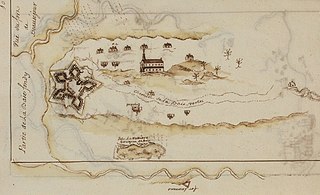
Fort Beauséjour, renamed Fort Cumberland in 1755, is a large, five-bastioned fort on the Isthmus of Chignecto in eastern Canada, a neck of land connecting the present-day province of New Brunswick with that of Nova Scotia. The site was strategically important in Acadia, a French colony that included primarily the Maritimes, the eastern part of Quebec, and northern Maine of the later United States. The fort was built by the French from 1751 to 1752. They surrendered it to the British in 1755 after their defeat in the Battle of Fort Beauséjour, during the Seven Years' War. The British renamed the structure as Fort Cumberland. The fort was strategically important throughout the Anglo-French rivalry of 1749–63, known as the French and Indian Wars by British colonists. Less than a generation later, it was the site of the 1776 Battle of Fort Cumberland, when the British forces repulsed sympathisers of the American Revolution.

The Battle of Fort Beauséjour was fought on the Isthmus of Chignecto and marked the end of Father Le Loutre's War and the opening of a British offensive in the Acadia/Nova Scotia theatre of the Seven Years' War, which would eventually lead to the end of the French colonial empire in North America. The battle also reshaped the settlement patterns of the Atlantic region, and laid the groundwork for the modern province of New Brunswick.

Fort Gaspareaux was a French fort at the head of Baie Verte near the mouth of the Gaspareaux River and just southeast of the modern village of Port Elgin, New Brunswick, Canada, on the Isthmus of Chignecto. It was built during Father Le Loutre's War and is now a National Historic Site of Canada overlooking the Northumberland Strait.

Fort Edward is a National Historic Site of Canada in Windsor, Nova Scotia, and was built during Father Le Loutre's War (1749-1755). The British built the fort to help prevent the Acadian Exodus from the region. The Fort is most famous for the role it played both in the Expulsion of the Acadians (1755) and in protecting Halifax, Nova Scotia from a land assault in the American Revolution. While much of Fort Edward has been destroyed, including the officers' quarters and barracks, the blockhouse that remains is the oldest extant in North America. A cairn was later added to the site.

Abbé Jean-Louis Le Loutre was a Catholic priest and missionary for the Paris Foreign Missions Society. Le Loutre became the leader of the French forces and the Acadian and Mi'kmaq militias during King George's War and Father Le Loutre's War in the eighteenth-century struggle for power between the French, Acadians, and Miꞌkmaq against the British over Acadia.
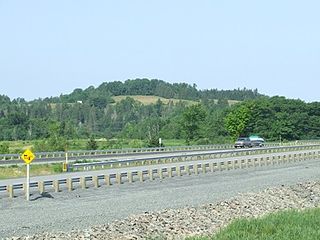
The Battle at St. Croix was fought during Father Le Loutre's War between Gorham's Rangers and Mi'kmaq at Battle Hill in the community of St. Croix, Nova Scotia. The battle lasted from March 20–23, 1750.

The siege of Grand Pré happened during Father Le Loutre's War and was fought between the British and the Wabanaki Confederacy and Acadian militia. The siege happened at Fort Vieux Logis, Grand-Pré. The native and Acadia militia laid siege to Fort Vieux Logis for a week in November 1749. One historian states that the intent of the siege was to help facilitate the Acadian Exodus from the region.
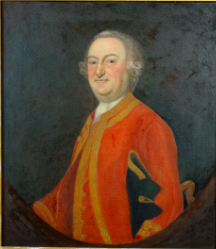
The Bay of Fundy campaign occurred during the French and Indian War when the British ordered the Expulsion of the Acadians from Acadia after the Battle of Fort Beauséjour (1755). The campaign started at Chignecto and then quickly moved to Grand-Pré, Rivière-aux-Canards, Pisiguit, Cobequid, and finally Annapolis Royal. Approximately 7,000 Acadians were deported to the New England colonies.
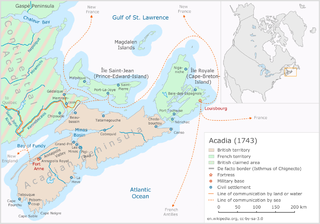
Father Le Loutre's War (1749–1755), also known as the Indian War, the Mi'kmaq War and the Anglo-Mi'kmaq War, took place between King George's War and the French and Indian War in Acadia and Nova Scotia. On one side of the conflict, the British and New England colonists were led by British officer Charles Lawrence and New England Ranger John Gorham. On the other side, Father Jean-Louis Le Loutre led the Mi'kmaq and the Acadia militia in guerrilla warfare against settlers and British forces. At the outbreak of the war there were an estimated 2500 Mi'kmaq and 12,000 Acadians in the region.

The Acadian Exodus happened during Father Le Loutre's War (1749–1755) and involved almost half of the total Acadian population of Nova Scotia deciding to relocate to French controlled territories. The three primary destinations were: the west side of the Mesagoueche River in the Chignecto region, Isle Saint-Jean and Île-Royale. The leader of the Exodus was Father Jean-Louis Le Loutre, whom the British gave the code name "Moses". Le Loutre acted in conjunction with Governor of New France Roland-Michel Barrin de La Galissonière who encouraged the Acadian migration. A prominent Acadian who transported Acadians to Ile St. Jean and Ile Royal was Joseph-Nicolas Gautier. The overall upheaval of the early 1750s in Nova Scotia was unprecedented. Present-day Atlantic Canada witnessed more population movements, more fortification construction, and more troop allocations than ever before in the region. The greatest immigration of the Acadians between 1749 and 1755 took place in 1750. Primarily due to natural disasters and British raids, the Exodus proved to be unsustainable when Acadians tried to develop communities in the French territories.

Fort Vieux Logis was a small British frontier fort built at present-day Hortonville, Nova Scotia, Canada in 1749, during Father Le Loutre's War (1749). Ranger John Gorham moved a blockhouse he erected in Annapolis Royal in 1744 to the site of Vieux Logis. The fort was in use until 1754. The British rebuilt the fort again during the French and Indian War and named it Fort Montague (1760).

Fort Menagoueche was a French fort at the mouth of the St. John River, New Brunswick, Canada. French Officer Charles Deschamps de Boishébert et de Raffetot and Ignace-Philippe Aubert de Gaspé built the fort during Father Le Loutre's War and eventually burned it themselves as the French retreated after losing the Battle of Beausejour. It was reconstructed as Fort Frederick by the British.

The Battle at Chignecto happened during Father Le Loutre's War when Charles Lawrence, in command of the 45th Regiment of Foot and the 47th Regiment, John Gorham in command of the Rangers and Captain John Rous in command of the navy, fought against the French monarchists at Chignecto. This battle was the first attempt by the British to occupy the head of the Bay of Fundy since the disastrous Battle of Grand Pré three years earlier. They fought against a militia made up of Mi'kmaq and Acadians led by Jean-Louis Le Loutre and Joseph Broussard (Beausoliel). The battle happened at Isthmus of Chignecto, Nova Scotia on 3 September 1750.
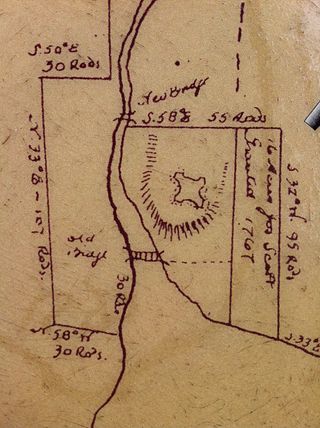
Fort Sackville was a British fort in present-day Bedford, Nova Scotia. It was built during Father Le Loutre's War by British adjacent to present-day Scott Manor House, on a hill overlooking the Sackville River to help prevent French, Acadian and Mi'kmaq attacks on Halifax. The fort consisted of a blockhouse, a guard house, a barracks that housed 50 soldiers, and outbuildings, all encompassed by a palisade. Not far from the fort was a rifle range. The fort was named after George Germain, 1st Viscount Sackville.
John Handfield was a British military officer, member of the Nova Scotia Council, and office holder.

The military history of the Acadians consisted primarily of militias made up of Acadian settlers who participated in wars against the English in coordination with the Wabanaki Confederacy and French royal forces. A number of Acadians provided military intelligence, sanctuary, and logistical support to the various resistance movements against British rule in Acadia, while other Acadians remained neutral in the contest between the Franco–Wabanaki Confederacy forces and the British. The Acadian militias managed to maintain an effective resistance movement for more than 75 years and through six wars before their eventual demise. According to Acadian historian Maurice Basque, the story of Evangeline continues to influence historic accounts of the expulsion, emphasising Acadians who remained neutral and de-emphasising those who joined resistance movements. While Acadian militias were briefly active during the American Revolutionary War, the militias were dormant throughout the nineteenth century. After confederation, Acadians eventually joined the Canadian War efforts in World War I and World War II. The most well-known colonial leaders of these militias were Joseph Broussard and Joseph-Nicolas Gautier.

John Hamilton was a British army officer of the 40th Regiment of Foot who fought in both King George's War and Father Le Loutre's War. He was eventually captured by a Mi'kmaq militia. He was an important prize for the Mi'kmaq because of his connections with the Nova Scotia establishment, his father and father-in-law being members of the Nova Scotia Council. He was also an artist and attempted to negotiate peace between the Mi'kmaq and British.
Texts
Endnotes